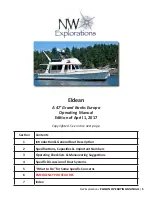
Information before you go sailing
•
Check the weather forecast.
•
Check drinking water for crew.
•
Check fuel tank level.
•
Check the power on your batteries are adequate . ( 12V optional )
•
Check engine oil on the engine.
•
When starting up the engine, check and make sure that cooling water is coming out.
If not, stop the engine and service it.
•
Check that both pumps are working, the installed one and the handheld pump.
•
Make sure that all equipment is stowed correctly and has been secured safely.
•
Check that water stays and rigging are intact.
•
Check that ALL hatches are closed – especially on the floats.
•
Check that there are life jackets for every crewmember on board.
•
If the boat is new, please note that electronics are not calibrated when the boat
leaves the yard.
IMPORTANT NOTICE
Beware of the following:
•
Make sure that there always are lifejackets and/or life preservers on board for the
whole crew – and use them!
•
Always as minimum we strongly recommend to use lifebelts outside the cockpit when
sailing or even motoring at night.
•
High tension/voltage cables. Mast height above sea level is approx. 14 metres/45 feet
– with no antennas. Also when trailering or moving the boat with mast up on the
trailer.
•
For long offshore crossings we recommend carrying a life raft in case of fire.
•
For long distance offshore sailing we recommend in main cabin a watertight flash
light and a bigger type knife to cut lines.
•
Take notice that the boat is not standard equipped with a Compass for navigation
•
Also make/prepare a watertight bag with a bit of food, handheld VHF and necessary
flayers in case of a capsize.
•
In case of capsize and you are inside the boat, only dive out if you have a knife with
you to cut lines if you get caught in lines.
•
By long distance sailing, make sure that all on board are aware of the above-
mentioned procedures.
•
For long distance sailing, make sure to have up-to-date flayers and other safety
devices, like Epirp etc.
•
We can only strongly recommend storing flares, knife, flash light,
Epirp/mobile/handheld VHF, a bit of water, in the emergency compartment, which is
accessible in capsized position on the SB side main hull outside just behind the aft
crossbeam (when capsized port side) rear/aft crossbeam.
Содержание 25 Touring
Страница 1: ...OWNER S MANUAL 25 Swing Wing...
Страница 7: ......
Страница 8: ......
Страница 9: ......
Страница 20: ......
Страница 26: ...Dragonfly 25 Touring...
Страница 27: ......
Страница 28: ......
Страница 29: ......
Страница 30: ...Dragonfly 25 Touring Mast Rotating System for mooring in folded position...
Страница 38: ......
Страница 40: ......
Страница 41: ......
Страница 42: ......
Страница 43: ......
Страница 51: ......
Страница 54: ......
Страница 55: ......











































